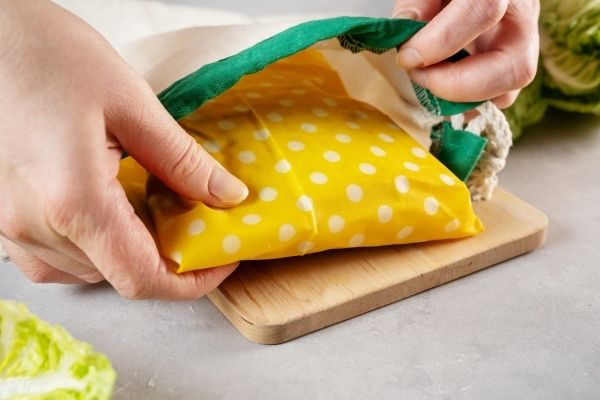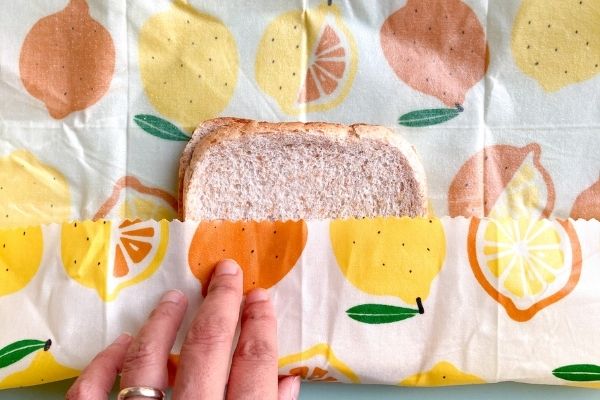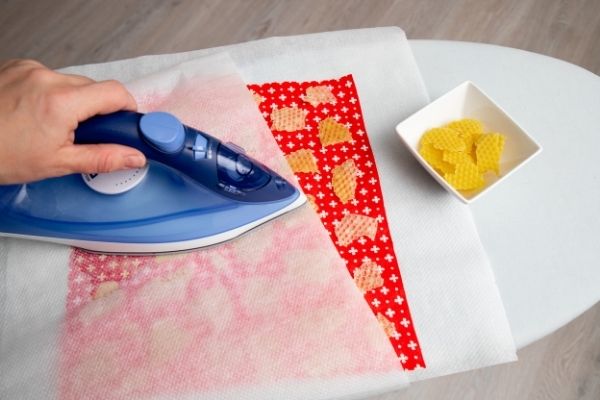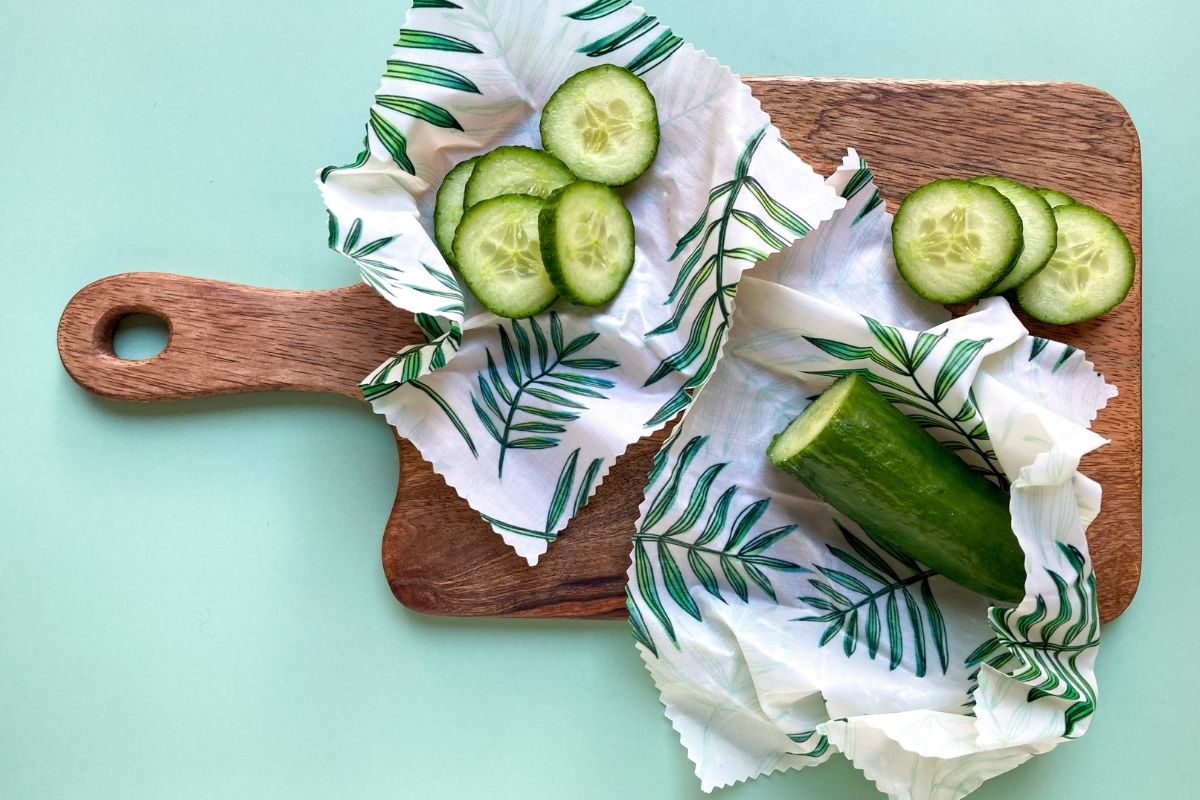What Are Beeswax Wraps | Eco-Friendly Alternatives To Plastic Wraps
Plastic pollution is a major issue that’s affecting our oceans, forests, and other ecosystems. Since this material takes years to break down, it sits in landfills or in outdoor areas for centuries, causing harm to plant and animal life.
One type of plastic that most of us use every day without a second thought is plastic wraps and bags. This convenient product lets us store food and keeps meals fresh. However, it also contributes to a huge environmental problem.
Beeswax wraps are a natural, reusable alternative to plastic wrap. They are biodegradable and don’t harm the environment and work just as well as traditional plastic wraps for storing food.
What Are Beeswax Wraps?

Beeswax food wrap is a product that’s made out of pieces of organic cotton that have been coated with beeswax, tree resin, and organic jojoba oil. The combination creates a food storage wrap that’s free of chemicals, reusable, and has natural antibacterial properties.
These wraps work because your hands’ warmth softens the wax and creates a tacky texture. That lets you then mold the wrap so that you can cover a container or package up food.
You can use beeswax food wrap to cover just about any item that you would use plastic wrap for. The only exception is that it should NOT be used with raw meat.
However, you can wrap cheese, bread, veggies, herbs, baked goods, and fruit in beeswax wrap without a problem. Or, you can use the wrap to cover the tops of bowls and jars so that you can store leftovers in the refrigerator.
Benefits of Beeswax Wraps
If you’re interested in getting started with beeswax wraps, you’ll be able to take advantage of a few key things. Let’s take a look at some of the top benefits of using beeswax wraps for food storage.
Are beeswax wraps natural?
Yes, they are!
Beeswax wraps are made out of natural and organic ingredients. What that means is that they’re biodegradable and can be composted once you’re done with them.
It also means that they won’t be bringing chemicals into contact with your food. You’ll be storing your food in a way that keeps your meals (and ultimately you) free from harmful toxins.
Is beeswax vegan or vegetarian?
Beeswax can be considered a vegetarian product, as it is made by animals but does not contain flesh – think of eggs or milk. However, the extraction of wax can cause disruption or even harm to bees – making beeswax a non-vegan product.
One way around this issue is to source wax from ethical local beekeepers who truly care for their bees. This kind of ethical approach is hard to find in large-scale operations.
Luckily, beekeeping is becoming widely popular – including in high-density areas such as New York City – and it is becoming easier to find genuine keepers who will sell or give you ethically sourced wax and deliciously fresh honey.
How can you dispose of beeswax wraps?
One of the biggest advantages of beeswax wraps is that you can reuse them for about 6 to 12 months or even longer – depending on the frequency of use and how you care for it.
But are they recyclable once they reach the end of their life? The bottom line is they should not go into your recycling bin, but there are other options for giving them a second life.
Beeswax itself is a natural product that is 100% safe for either traditional composting or bokashi, nevertheless, the fabric used to make your wrap will take ages to break down. So, the best ‘end of life’ option for your food wraps is to turn them into things like show polish cloth or wooden furniture cloth.
Beeswax are cost-effective
Purchasing plastic wraps can quickly add up. Since you throw the plastic wrap away after every use, you’re essentially throwing money down the drain.
Beeswax wraps are a much more cost-effective option because they’re long-lasting. You’ll spend less money in the long run when you use beeswax wraps in your kitchen.
Versatility
There are tons of different uses for beeswax wraps, which is part of what makes them so handy. You can use them to cover veggies, fruit, leftovers, bread, and cheese without any issue.
Downsides of Beeswax Wraps
While the benefits of beeswax wraps far outweigh the limitations, it’s still important to be aware of what those limitations are. Let’s take a look at the issues you might have with beeswax wraps.
Because beeswax wraps are made out of wax, they’ll leave behind a slight residue on your dishes and on your hands. The residue is pieces of waxy coating that flakes off the wraps.
Beeswax may leave behind residue
The good news is that this issue doesn’t last. The more you use your beeswax wraps, the less residue you’ll notice coming off them.
Wax can melt
You need to be careful when using beeswax wraps because the wax on them can melt. You can’t use them on hot food nor can you leave them out in direct sunlight because this will cause the wax to run. I would also recommend not using them on very hot days unless you have a cold insulated bag or container that keeps them cool.
Beeswax wraps can be pricey
There’s quite a high demand for beeswax wraps, which means that they’re often a little pricey. Regardless of which brand of wraps you choose to purchase, you’ll find that they’re more costly than traditional plastic wrap.
The good news here is that even though the upfront investment is often quite high, over time you’ll end up saving money. Since you can reuse these wraps, you won’t have to keep purchasing them like you would plastic wrap.
Wraps can easily stain
Beeswax wraps pick up trace amounts of color and oil from the foods and spices that you store in them. That can lead to stains on your precious wax wraps.
To keep the wraps from staining, all you need to do is take a few preventative measures. Simply blot away any excess oils or colors before you store messier foods in these wraps.
Are Beeswax Wraps Reusable?

One huge benefit of beeswax wraps is that they’re a reusable product. After you’ve finished with them, you can just wash them with cool water and a little bit of soap before drying them out and reusing them.
Typically, beeswax wraps will last you for about a year before you’ll need to replace them. Once you’ve got all the use that you can out of them, you can either use them as a fire starter or cut them into strips for composting.
If you’ve just bought your beeswax wraps and are ready to reuse them, however, here’s how to prep them for their next use.
Washing your beeswax wraps
To wash the wraps, run them under cool water. Make sure not to use hot water as this can cause the wax to melt and ruin the wraps.
Then, rub the wraps with a little bit of eco-friendly soap using a sponge or a cloth. After rubbing them with the soap for a few minutes, rinse the beeswax wraps off.
Drying your beeswax wraps
When you’ve finished washing your beeswax wraps, it’s time to dry them. Beeswax wraps need to be air-dried and cannot be placed in a dryer or set by a heater.
The best way to dry them is to hang them on a small clothing line or to drape them over your faucet. Or, you can hang them off your dishrack until they’re fully dry.
Don’t wring out your beeswax wraps. Instead, spread them out flat and allow them to dry laying open.
Storing your beeswax wraps
When your beeswax wraps are fully dry, gently fold them and place them on a shelf, in a basket, or in a drawer. Just make sure that they’re in a place where they won’t get wet and where they’re easy to reach for their next use.
How to Revive Beeswax Wraps

After you’ve used your beeswax wraps several times, you may notice that they start to look a bit crumpled. That doesn’t mean that it’s time to compost them, however! You can revive your beeswax wraps to keep getting use out of them.
To revive your wax wraps, you’ll need to find an old cookie sheet. Make sure that you choose a baking tray that you don’t care about, as this job can get a bit messy.
You’ll also need a silicone baking mat for this project. If you want, you can pick up some grated beeswax, too.
To revive the wraps, start by preheating the oven to 280ºF. While the oven is heating, place the silicone baking mat on your baking tray and spread your beeswax wrap out on top of the mat.
If you see that there are a few patches where your wax wrap has worn off, you can sprinkle grated beeswax over those sections.
Next, place the baking sheet in the oven but leave the door open. Keep an eye on the warp and warm it for about 2-3 minutes.
After you notice that the wax wrap has melted, carefully remove the wrap from the oven. Lift the melted wrap up by its corners and hang it on a clothesline to dry.
The wrap should dry in just a minute or two. Then, you’re ready to reuse it to store your foodstuffs!
How to DIY Beeswax Wraps

Because beeswax wraps are made out of a few, simple ingredients, you can actually make them at home yourself. DIYing your beeswax wraps can be a more cost-effective way of investing in these wraps. There are many recipes to choose from! Below is one of them:
To make these wraps, you’ll need:
- A sheet of organic, 100% cotton fabric
- 0.75 ounces of pine resin
- 0.5 ounces of organic carnauba wax
- 1 tablespoon of organic jojoba oil
- 1 popsicle stick
- 1 sheet of parchment paper
- 1 paintbrush
With those tools on hand, it’s time to get to work! Start by washing and drying your fabric. Then, cut the fabric into your desired shapes and sizes for your beeswax wraps. Set the fabric to the side.
Now, put the wax, oil, and resin into a double boiler. Add water to the double boiler until the wax mixture is sitting below the waterline and turn the burner to medium-high heat. Let the ingredients melt together for about 25 minutes.
Meanwhile, preheat the oven to 300ºF. Cover a large baking tray with a sheet of parchment paper. The sheet of parchment paper should be bigger than your largest piece of cloth.
Next, spread your pieces of cloth on the parchment paper. Gently brush your now melted wax mixture onto the fabric. Be careful not to oversaturate your cloth.
Once the cloth is fully saturated, place the baking tray in the oven for two minutes. When the fabric looks wet, remove the sheet from the oven and brush more mixture over any dry spots on the fabric. Then, place it back in the oven for another two minutes.
When the fabric once again looks wet, remove the sheet from the oven and hang your new beeswax wraps on a clothesline. The wraps should dry in a couple of minutes.
Voilá! You’ve got some fresh pieces of beeswax wrap that you can now use to store your foods.
Here is another easy DIY beeswax wraps video tutorial:
Frequently Asked Questions
We know you’ve still got tons of questions about beeswax wraps. To make sure you fully understand this product, check out these answers to a few commonly asked questions.
How well do beeswax wraps work?
The effectiveness of beeswax wraps depends on the shelf life of each item you’re using, but it can last for a pretty long time. If you use beeswax wrap to freeze food, it’s good for up to three weeks. If you are storing food in the fridge, they’ll keep for about a week.
How long does beeswax wrap last?
Most of the time beeswax wrap will last for between 6 and 12 months. However, if you look after them well, you can make them last even longer. One great way to keep your beeswax wraps working is to place them in the oven to revitalize them.
Do beeswax wraps make food taste funny?
If you’re storing food in direct contact with your beeswax wraps, you may notice that they impart a mild honey flavor into your food. However, you won’t necessarily notice the flavor unless you’re really paying attention.
What is beeswax wrap made out of?
Beeswax wrap is made out of organic cotton cloth, beeswax, and jojoba oil. You can actually make beeswax wraps yourself if you have these ingredients on hand.
What can I use my beeswax food wraps for?
You can use beeswax for half-used vegetables such as limes and avocados, to wrap blocks of cheese or deli items, to cover sandwiches and dry-prepared foods, store cookie dough in the freezer, and wrap loaves of bread.
What should you not use beeswax wraps on?
You can use beeswax wraps on just about any food except for fish, meat, and poultry. You should also remove beeswax wraps before placing wrapped food in the microwave or oven, as this can damage the wraps.






